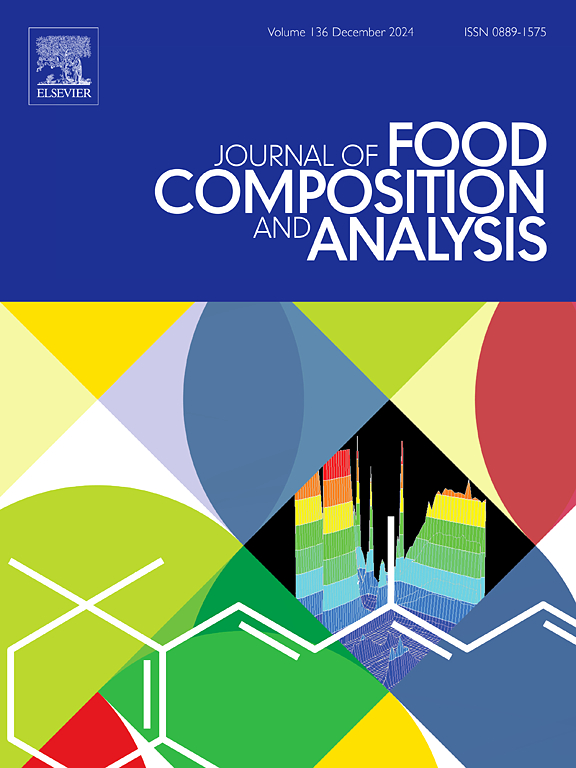A smartphone-assisted colorimetric test kit for the determination of indole-3-carbinol in dietary supplements
IF 4.6
2区 农林科学
Q2 CHEMISTRY, APPLIED
引用次数: 0
Abstract
This work introduces a sol-gel test kit for the colorimetric determination of indole-3-carbinol (I3C) in dietary supplements sold in health food, pharmacies, and online sources. The test kit comprises a chromogenic reagent of para-dimethylaminocinnamaldehyde (DMACA) entrapped within a sol-gel matrix. The assay relies on the reaction of indole-3-carbinol with DMACA under acidic conditions to form a dark red-violet azafulvenium salt. Color changes are clearly visible to the naked eye and are evaluated with a smartphone application. Under optimized conditions, the method demonstrated a linear calibration range of 10–100 mg L–1 (r² = 0.9892), with detection and quantification limits of 2.0 mg L⁻¹ and 6.7 mgL–1, respectively. The smartphone-assisted colorimetric method showed good intra- and inter-day precision, with % RSDs lower than 8.1 %, and good accuracy, with acceptable relative errors in the range of 12.9–13.8 %. The sol-gel test kit showed long-term storage stability for two months at −18°C. For the analysis of ten dietary supplement products, smartphone-assisted colorimetric test kit is in good agreement with high-performance liquid chromatography with an ultraviolet detector (HPLC-UV) as reference method. This low-cost, portable and disposable test kit offers as an alternative approach for monitoring the quality of indole-3-carbinol dietary supplement.
一种智能手机辅助比色法测定膳食补充剂中吲哚-3-甲醇的试剂盒
本工作介绍了一种溶胶-凝胶测试试剂盒,用于比色测定保健食品、药店和网上销售的膳食补充剂中的吲哚-3-甲醇(I3C)。该检测试剂盒包括一种在溶胶-凝胶基质中包裹的对二甲氨基茚三醛(DMACA)显色试剂。该试验依靠吲哚-3-甲醇与DMACA在酸性条件下反应形成深紫红色的阿扎绿盐。颜色变化可以用肉眼清晰地看到,并可以通过智能手机应用程序进行评估。在优化条件下,该方法的线性定标范围为10 ~ 100 mg - 1 (r²= 0.9892),检测限和定量限分别为2.0 mg L - 1 和6.7 mg - 1。智能手机辅助比色法具有良好的日内、日间精密度,rsd < 8.1 %,准确度良好,可接受的相对误差范围为12.9 ~ 13.8 %。溶胶-凝胶测试试剂盒在- 18°C下可长期保存2个月。在对10种膳食补充剂产品的分析中,智能手机辅助比色试剂盒与高效液相色谱-紫外检测器(HPLC-UV)作为参比方法的一致性较好。这种低成本、便携和一次性的检测试剂盒为监测吲哚-3-甲醇膳食补充剂的质量提供了一种替代方法。
本文章由计算机程序翻译,如有差异,请以英文原文为准。
求助全文
约1分钟内获得全文
求助全文
来源期刊

Journal of Food Composition and Analysis
工程技术-食品科技
CiteScore
6.20
自引率
11.60%
发文量
601
审稿时长
53 days
期刊介绍:
The Journal of Food Composition and Analysis publishes manuscripts on scientific aspects of data on the chemical composition of human foods, with particular emphasis on actual data on composition of foods; analytical methods; studies on the manipulation, storage, distribution and use of food composition data; and studies on the statistics, use and distribution of such data and data systems. The Journal''s basis is nutrient composition, with increasing emphasis on bioactive non-nutrient and anti-nutrient components. Papers must provide sufficient description of the food samples, analytical methods, quality control procedures and statistical treatments of the data to permit the end users of the food composition data to evaluate the appropriateness of such data in their projects.
The Journal does not publish papers on: microbiological compounds; sensory quality; aromatics/volatiles in food and wine; essential oils; organoleptic characteristics of food; physical properties; or clinical papers and pharmacology-related papers.
 求助内容:
求助内容: 应助结果提醒方式:
应助结果提醒方式:


